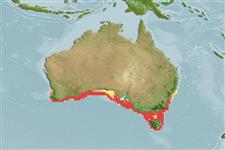Elasmobranchii (sharks and rays) >
Rajiformes (Skates and rays) >
Rajidae (Skates)
Eponymy: Gilbert Percy Whitley (1903–1975) was a British-born Australian ichthyologist and malacologist. [...] (Ref. 128868), visit book page.
Environment: milieu / climate zone / depth range / distribution range
Ecology
Marine; demersal; depth range 1 - 170 m (Ref. 6871). Temperate; 32°S - 44°S, 115°E - 153°E (Ref. 114953)
Eastern Indian Ocean: endemic to southern Australia.
Size / Weight / Age
Maturity: Lm ? range ? - ? cm
Max length : 200 cm TL male/unsexed; (Ref. 114953)
Short description
Identification keys | Morphology | Morphometrics
Dorsal surface greyish or greyish brown with irregularly spaced white flecks, ventral surface cream or white, occasionally with greyish areas. Disc quadrangular, broader than long. Snout of moderate length, broadly rounded and knob-like at snout tip. Tail short, very depressed, broad; lateral skin folds prominent. A row of 1-5 thorns on nuchal and shoulder region, orbital and malar thorns absent. Alar thorns retractable. Tail with 1-3 rows of thorns, outer rows located near lateral margin.
Most abundant in shallow water near shore (Ref. 6871). Found over soft bottom (Ref. 7300, 75154). Recorded to be found at 345 m depth (Ref. 114953). Diet mainly consists of crabs, octopuses and small bony fishes (Ref. 114953). Oviparous (Ref. 50449). Males reaches maturity at ca. 127 cm TL (Ref. 114953). Eggs have horn-like projections on the shell (Ref. 205). Egg cases ca. 22 cm long, hatch size at ca. 20 cm TL (Ref. 114953). Thorny tail can inflict a minor injury (Ref. 6871).
Life cycle and mating behavior
Maturity | Reproduction | Spawning | Eggs | Fecundity | Larvae
Oviparous, paired eggs are laid. Embryos feed solely on yolk (Ref. 50449).
Last, P.R. and J.D. Stevens, 1994. Sharks and rays of Australia. CSIRO, Australia. 513 p. (Ref. 6871)
IUCN Red List Status (Ref. 130435: Version 2024-2)
Threat to humans
Traumatogenic (Ref. 6871)
Human uses
Tools
Special reports
Download XML
Internet sources
Estimates based on models
Preferred temperature (Ref.
123201): 14 - 18.2, mean 16.3 °C (based on 139 cells).
Phylogenetic diversity index (Ref.
82804): PD
50 = 1.0000 [Uniqueness, from 0.5 = low to 2.0 = high].
Bayesian length-weight: a=0.00302 (0.00141 - 0.00645), b=3.24 (3.07 - 3.41), in cm total length, based on LWR estimates for this (Sub)family-body shape (Ref.
93245).
Trophic level (Ref.
69278): 4.0 ±0.6 se; based on size and trophs of closest relatives
Resilience (Ref.
120179): Low, minimum population doubling time 4.5 - 14 years (Fec assumed to be <100).
Fishing Vulnerability (Ref.
59153): Very high vulnerability (90 of 100).
Nutrients (Ref.
124155): Calcium = 6.63 [1.27, 32.23] mg/100g; Iron = 0.262 [0.068, 0.736] mg/100g; Protein = 17.3 [14.6, 20.0] %; Omega3 = 0.728 [0.235, 2.708] g/100g; Selenium = 13.4 [3.9, 43.6] μg/100g; VitaminA = 10.1 [3.3, 32.6] μg/100g; Zinc = 0.335 [0.162, 0.594] mg/100g (wet weight);
